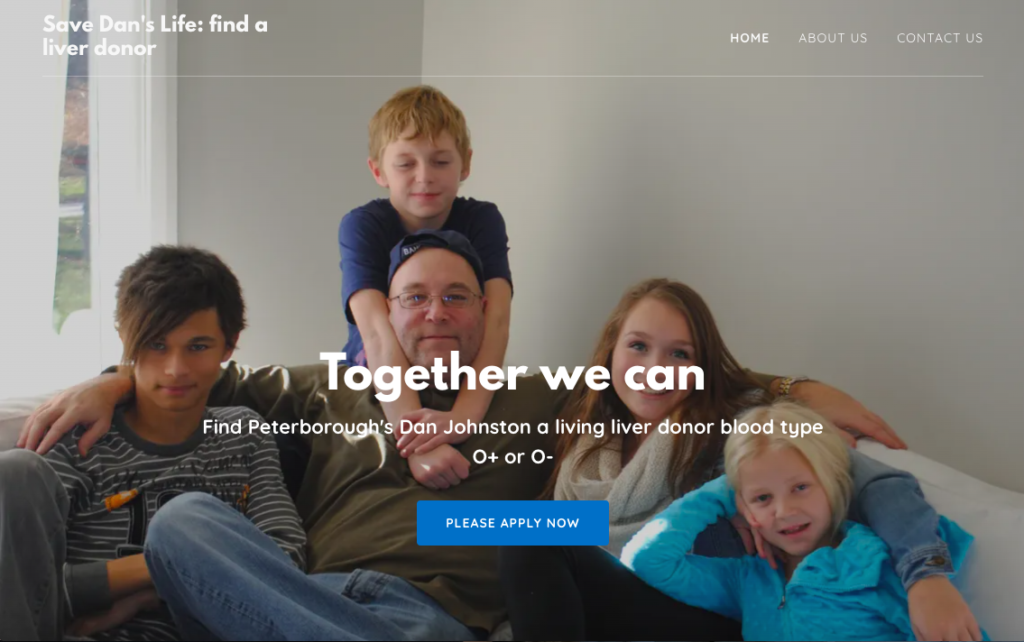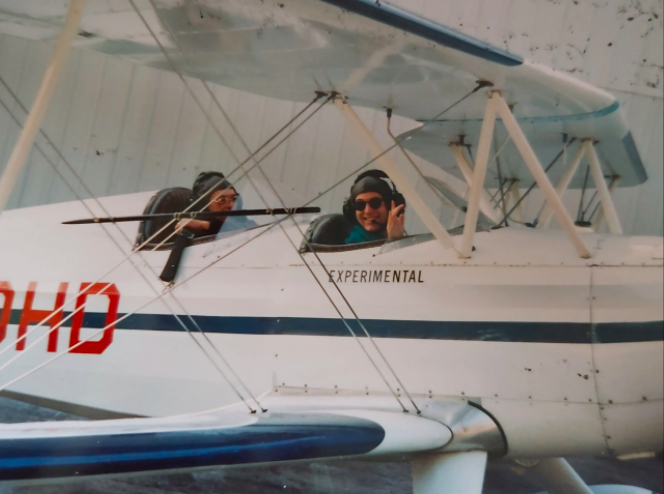Dan Johnston, a 53-year-old man from Peterborough, was living a healthy life when he was diagnosed with a chronic degenerative liver disease called cirrhosis and almost died.
Johnston became aware of his fight against cirrhosis after he decided to embark on a personal fitness journey.
“I decided to start getting in as good a shape as I could so I started doing yoga a couple of hours a day, and I started running for the first time. I was in great shape, I felt great then one day I was sitting watching Jeopardy and I felt nausea so I got up and I began projectile vomiting blood,” Johnston said.
After being rushed to the hospital and receiving life-saving blood transfusions, Johnston learned he had suffered from bleeding esophageal varices — a life-threatening condition often attributed to cirrhotic patients which occurs when swollen veins (varices) in the lower esophagus rupture and bleed.
“I was told immediately I needed a liver transplant or [I’d face] death,” Johnston said.
Now Johnston is searching for a living liver donor to save his life since no match has been found from his family. A donor can be any healthy person aged 18 to 60 with O+ or O- blood type and a healthy body mass index. Only healthy applicants are allowed to donate and once they do, their liver will grow back as strong as ever in two to three months. Due to his blood type and chemistry as well as the shortage of organs, Johnston will not be able to wait for a donation from a deceased donor to save his life. A living donor is his only option.

Need for proactive support
Since his diagnosis, Johnston had to make many difficult decisions not only for himself, but also for his mother as he is no longer able to care for her and had to place her in a senior care facility. As he began to navigate the stressful process of searching for a living liver donor while dealing with his debilitating condition, Johnston found his personal experience to be riddled with delayed communication and a lack of support.
“Nobody really told me what to expect and I wish they did because it has been way worse than I thought it was going to be,” Johnston said. “There has been a lot of trial and error and I hurt myself a lot trying to figure things out for things I feel I should have been prepared for.”
Following his initial diagnosis of cirrhosis, Johnston suffered from the development of complications including ascites, which is the painful build up of fluid in the abdomen. This condition requires that Johnston wear a girdle every day and make weekly hospital visits to have the fluid drained by a needle the size of his little finger stuck into his abdomen.
Complications also include hepatic encephalopathy, a condition that leads to an altered level of consciousness due to liver failure. For Johnston, this meant that because his liver is unable to remove toxins such as ammonia from his blood, he has suffered brain damage. Johnston said he knows he has been affected by ammonia toxicity because he can’t read anymore or articulate himself as well as he once could due to a sense of confusion and lack of focus. The brain damage has also caused him to lose consciousness.
“I did not know what to look for and I almost died because of it,” Johnston said. “My sister came over once and I was unconscious, naked on the dining room floor, the house was trashed, and I had cuts all over myself. I had no idea what had gone on and if she hadn’t come over I could have died within a few hours.”

Bureaucracy affecting care
Johnston’s challenges have not been exclusively medical, but also administrative. It took about a year from the time he was first diagnosed and told he needed a transplant to live before he finally got onto the proper transplant waitlist. These delays were further extended due to the COVID-19 crisis.
“I thought I was on the transplant list but I wasn’t because I needed to get a cardiac angiogram done, and they weren’t doing those because COVID-19, it’s possible I lost a donor because of that,” he said.
According to a statement on behalf of Canadian Blood Services many organ and tissue programs across Canada began to modify or suspend operations in March in response to the COVID-19 pandemic to protect donors and transplant candidates in Canada.
“The decision to proceed with organ donation and transplantation depends on a variety of factors, such as the prevalence of COVID-19 in a particular area, individual hospital capacity and other resource and safety considerations,” the statement reads.
Once Johnston receives a transplant from a living donor, he would like to dedicate his time to finding solutions to bridge these gaps of knowledge for future patients.
According to Toronto-based University Health Network (UHN) four out of 10 people on the liver transplant waitlist will die or be removed from the list while waiting for an organ. This is approximately 30 to 60 people in Canada each year.
Preliminary data made available by Trillium Gift for Life as of June 28, also found there were 290 patients waiting for a deceased liver transplant. No numbers were available for those searching for living liver donors as Johnston is currently doing.

Why donors do it
For liver donor Heather Badenoch, she said the notion that someone might lose a loved one without having gotten a fighting chance at recovery was a really awful idea for her, which is what eventually led her to become a donor.
Badenoch said she read stories about people looking for organ donors for years, but when 8-year-old Gianna-Lynn Favilla made a public plea for a liver donor in 2016, something changed.
“I just decided on the spot ‘I’m going to give to her,’ we have the same blood type and I’m just going to give to her,” Badenoch said. “That’s true of most donors I know, whether we are giving to strangers, people we know or friend of friends it’s like a snap decision. We just decide: I can help with that.”
Favilla ended up receiving a transplant from another donor, but Badenoch asked to stay in the screening process to donate to whoever needed a liver most.
In 2018, Badenoch underwent organ transplant surgery at Toronto General Hospital and donated 22 per cent of her liver to an anonymous child.
“It’s without a doubt the best thing I’ve ever done,” Badenoch said. “To me, it is this remarkable experience to have been a part of saving someone’s life, it’s kind of this overwhelming notion that out there is some kid that is alive, I love that.”
She added that the anonymity of her donation adds to the sense of community involvement, and also ensures all waitlisted patients get an equal fighting chance without prejudice getting in the way.
“It could have been anybody,” she said. “When you enter the process to be what’s called a non-directed donor, you have to open in your heart to [the recipient] being anybody.”
From the beginning of the process, Badenoch did rigorous research and was confident in the transplant team at Toronto General who according to UHN, has performed nearly 900 living liver donor transplants with excellent outcomes for recipients and donors since 2000.
“I was always optimistic that everything was going to turn out ok, the team is very, extremely honest with you about the risks of complications about all the things that could go wrong and they really look out for us,” Badenoch said.

COVID-19 changes
Badenoch also explained how COVID-19 has been a challenge for many transplant candidates due to the delays in treatments.
“At Toronto General they did continue to do liver transplants in the most serious of cases but where the recipients were healthy enough they did put things on hold. Things have started back up again — I know of three transplants that happened last week alone,” Badenoch said.
She added that she understands why medical professionals put some of the transplants on pause.
“That was for really good reason, it was for everyone’s safety, it was to avoid transmission [of COVID-19],” she said. “I think the transplant community understood and the transplant team was really candid about the situation.”
According to Canadian Blood Services as select programs are beginning to re-expand their services and select living donation programs are resuming activity, the organization is implementing creative, long-term solutions for the lasting benefit of donors and transplant candidates.
One new solution is that organs can now be shipped across Canada instead of requiring donors to travel far from home to be closer to transplant recipients, Canadian Blood Services said.
Call to action
Since the transplant, Badenoch, who runs a PR agency for not-for-profits, has built an informal network of living donors and liver transplant patients as she helps current patients campaign online to find donors.
“I can’t be a liver donor twice, but I feel that by helping other people find a donor I’m helping to save a life another time,” she said.
Badenoch added that she has always been an action-driven person, so to her, awareness alone is not enough. At a minimum, she said she makes sure people know how to register as organ donors.
“I’m so glad I [donated], I would do it again, it’s such a beautiful and supportive community to be a part of and ultimately being a living donor the recovery process can be months but it’s months out of my life to give someone else their whole life.”
To learn more about how you can help Dan Johnston go to savedanslife.ca
For more information on how to apply to become a living liver donor go to www.uhn.ca/Transplant/Living_Donor_Program/Pages/living_liver_donor
Featured image courtesy of savedanslife.ca.






